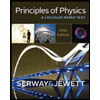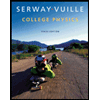1) A ball of mass, m = 2.50 kg, floats on a pool of fluid, L-1.00 m wide. It is attached to supports at either end of the pool by springs, as shown in Fig.-1. The left spring has a spring constant, A = 65.0 N/m, and equilibrium length, L1-0.600 m. The spring on the right has a spring constant, k2-75.0N/m, and equilibrium length, L20.800m L = 1.00 m ki, Li Figure 1 -A ball of mass, m = 2.50 kg, floats on a pool of fluid, L = 1.00 m wide. It is attached to supports at either end of the pool by springs. The left spring has a spring constant, A = 65.0 N/m, and equilibrium length, L1 = 0.600 m. The right spring has a spring constant. ka = 75.0 N/m, and equilibrium length, L2 = 0.800 m. (Not to scale.) a) The ball is initially at rest at position, x - d. It's then pulled to the center between the two supports at 0.500 m, and let go. How long after it's let go does it take to return to x- d? (Neglect the drag of the fluid.) Supposing we now consider that the fuld exerts a drag force on the ball of fD b 20.0kg/s. If the ball is again pulled to the center at aand let go, now how long does it take to return to the position, x = d? b) -bu, where c) In Part b, once the ball gets back to the position, x - d, what's the furthest it will get from r-d after that? d) Supposing the drag coefficient is changed to b = 40.0 kg/s. If the ball is again pulled to the center at and let go, now how long does it take to return to the position, x-d? 2 e) Going back to Part b with the drag coefficient given by b -20.0 kg/s, supposing the ball is initially at rest at x - d. But then it's driven with a driving force given by F (50.0N) cos [(8.00s) ]. After a long time has passed, how fast will the ball be traveling whenever it passes through the point where x?
1) A ball of mass, m = 2.50 kg, floats on a pool of fluid, L-1.00 m wide. It is attached to supports at either end of the pool by springs, as shown in Fig.-1. The left spring has a spring constant, A = 65.0 N/m, and equilibrium length, L1-0.600 m. The spring on the right has a spring constant, k2-75.0N/m, and equilibrium length, L20.800m L = 1.00 m ki, Li Figure 1 -A ball of mass, m = 2.50 kg, floats on a pool of fluid, L = 1.00 m wide. It is attached to supports at either end of the pool by springs. The left spring has a spring constant, A = 65.0 N/m, and equilibrium length, L1 = 0.600 m. The right spring has a spring constant. ka = 75.0 N/m, and equilibrium length, L2 = 0.800 m. (Not to scale.) a) The ball is initially at rest at position, x - d. It's then pulled to the center between the two supports at 0.500 m, and let go. How long after it's let go does it take to return to x- d? (Neglect the drag of the fluid.) Supposing we now consider that the fuld exerts a drag force on the ball of fD b 20.0kg/s. If the ball is again pulled to the center at aand let go, now how long does it take to return to the position, x = d? b) -bu, where c) In Part b, once the ball gets back to the position, x - d, what's the furthest it will get from r-d after that? d) Supposing the drag coefficient is changed to b = 40.0 kg/s. If the ball is again pulled to the center at and let go, now how long does it take to return to the position, x-d? 2 e) Going back to Part b with the drag coefficient given by b -20.0 kg/s, supposing the ball is initially at rest at x - d. But then it's driven with a driving force given by F (50.0N) cos [(8.00s) ]. After a long time has passed, how fast will the ball be traveling whenever it passes through the point where x?
University Physics Volume 1
18th Edition
ISBN:9781938168277
Author:William Moebs, Samuel J. Ling, Jeff Sanny
Publisher:William Moebs, Samuel J. Ling, Jeff Sanny
Chapter15: Oscillations
Section: Chapter Questions
Problem 60AP: A mass is placed on a frictionless, horizontal table. A spring (k=100N/m) , which can be stretched...
Related questions
Question
![1) A ball of mass, m = 2.50 kg, floats on a pool of fluid, L-1.00 m wide. It is attached to supports
at either end of the pool by springs, as shown in Fig.-1. The left spring has a spring constant,
A = 65.0 N/m, and equilibrium length, L1-0.600 m. The spring on the right has a spring
constant, k2-75.0N/m, and equilibrium length, L20.800m
L = 1.00 m
ki, Li
Figure 1 -A ball of mass, m = 2.50 kg, floats on a pool of fluid, L = 1.00 m wide. It is
attached to supports at either end of the pool by springs. The left spring has a spring constant,
A = 65.0 N/m, and equilibrium length, L1 = 0.600 m. The right spring has a spring constant.
ka = 75.0 N/m, and equilibrium length, L2 = 0.800 m. (Not to scale.)
a) The ball is initially at rest at position, x - d. It's then pulled to the center between the two
supports at 0.500 m, and let go. How long after it's let go does it take to return to
x- d? (Neglect the drag of the fluid.)
Supposing we now consider that the fuld exerts a drag force on the ball of fD
b 20.0kg/s. If the ball is again pulled to the center at aand let go, now how long does
it take to return to the position, x = d?
b)
-bu, where
c) In Part b, once the ball gets back to the position, x - d, what's the furthest it will get from
r-d after that?
d) Supposing the drag coefficient is changed to b = 40.0 kg/s. If the ball is again pulled to the
center at and let go, now how long does it take to return to the position, x-d?
2
e) Going back to Part b with the drag coefficient given by b -20.0 kg/s, supposing the
ball is initially at rest at x - d. But then it's driven with a driving force given by
F (50.0N) cos [(8.00s) ]. After a long time has passed, how fast will the ball be traveling
whenever it passes through the point where x?](/v2/_next/image?url=https%3A%2F%2Fcontent.bartleby.com%2Fqna-images%2Fquestion%2F148f708e-8a5d-4fc9-84e5-edc45b43bb5d%2Fa299e7bf-903f-4a41-9eff-a9d5c6b63d4c%2F17pk2ss.png&w=3840&q=75)
Transcribed Image Text:1) A ball of mass, m = 2.50 kg, floats on a pool of fluid, L-1.00 m wide. It is attached to supports
at either end of the pool by springs, as shown in Fig.-1. The left spring has a spring constant,
A = 65.0 N/m, and equilibrium length, L1-0.600 m. The spring on the right has a spring
constant, k2-75.0N/m, and equilibrium length, L20.800m
L = 1.00 m
ki, Li
Figure 1 -A ball of mass, m = 2.50 kg, floats on a pool of fluid, L = 1.00 m wide. It is
attached to supports at either end of the pool by springs. The left spring has a spring constant,
A = 65.0 N/m, and equilibrium length, L1 = 0.600 m. The right spring has a spring constant.
ka = 75.0 N/m, and equilibrium length, L2 = 0.800 m. (Not to scale.)
a) The ball is initially at rest at position, x - d. It's then pulled to the center between the two
supports at 0.500 m, and let go. How long after it's let go does it take to return to
x- d? (Neglect the drag of the fluid.)
Supposing we now consider that the fuld exerts a drag force on the ball of fD
b 20.0kg/s. If the ball is again pulled to the center at aand let go, now how long does
it take to return to the position, x = d?
b)
-bu, where
c) In Part b, once the ball gets back to the position, x - d, what's the furthest it will get from
r-d after that?
d) Supposing the drag coefficient is changed to b = 40.0 kg/s. If the ball is again pulled to the
center at and let go, now how long does it take to return to the position, x-d?
2
e) Going back to Part b with the drag coefficient given by b -20.0 kg/s, supposing the
ball is initially at rest at x - d. But then it's driven with a driving force given by
F (50.0N) cos [(8.00s) ]. After a long time has passed, how fast will the ball be traveling
whenever it passes through the point where x?
Expert Solution
This question has been solved!
Explore an expertly crafted, step-by-step solution for a thorough understanding of key concepts.
This is a popular solution!
Trending now
This is a popular solution!
Step by step
Solved in 7 steps with 6 images

Recommended textbooks for you

University Physics Volume 1
Physics
ISBN:
9781938168277
Author:
William Moebs, Samuel J. Ling, Jeff Sanny
Publisher:
OpenStax - Rice University

Physics for Scientists and Engineers, Technology …
Physics
ISBN:
9781305116399
Author:
Raymond A. Serway, John W. Jewett
Publisher:
Cengage Learning

College Physics
Physics
ISBN:
9781938168000
Author:
Paul Peter Urone, Roger Hinrichs
Publisher:
OpenStax College

University Physics Volume 1
Physics
ISBN:
9781938168277
Author:
William Moebs, Samuel J. Ling, Jeff Sanny
Publisher:
OpenStax - Rice University

Physics for Scientists and Engineers, Technology …
Physics
ISBN:
9781305116399
Author:
Raymond A. Serway, John W. Jewett
Publisher:
Cengage Learning

College Physics
Physics
ISBN:
9781938168000
Author:
Paul Peter Urone, Roger Hinrichs
Publisher:
OpenStax College

Principles of Physics: A Calculus-Based Text
Physics
ISBN:
9781133104261
Author:
Raymond A. Serway, John W. Jewett
Publisher:
Cengage Learning

College Physics
Physics
ISBN:
9781285737027
Author:
Raymond A. Serway, Chris Vuille
Publisher:
Cengage Learning

College Physics
Physics
ISBN:
9781305952300
Author:
Raymond A. Serway, Chris Vuille
Publisher:
Cengage Learning